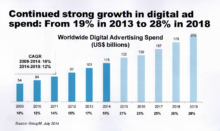Digital Plonkers

WPP’s annual digital investor day provided Sir Martin Sorrell another opportunity to show off his digital wares as well as take some entertaining swings at rivals; particularly the “plonkers†who had recently been over-paying (ie out-bidding WPP) for digital assets and particularly those in Brazil. Comment est-ce qu’on dit ça en Francaise Maurice?
At some point ‘digital’ media and interaction will become so ubiquitous, it will become obsolete to try and split it out as a discrete area of activity for marketing agencies. In the meantime it will provide a rich seam to be mined for corporate finance and purveyors of charts showing the exciting growth opportunities in most things digital that can be displayed to starry-eyed investors.
Yesterday’s digital investor day by WPP therefore pretty much delivered to cue; lots of charts with lines rising diagonally from bottom left to top right together with accompanying suits from often recently acquired digital properties to explain why their piece of the pie was going to grow faster than everyone else’s. This was clearly not the forum for discussing falling gross margins, sub-GDP net sales growth or the reliance on acquired digital skills and the extent to which these acquired intangibles are consumed and therefore ought to be recognised as a real P&L and cash flow expense.
Amongst all of the digital brouhaha however was a chart that was so incongruous as to represent a sort of Banquo’s ghost. This was the rather worn analysis of comparing time spent on various media with the proportion of advertising expenditure. The premise of course is that the two should ultimately converge and therefore digital budgets (especially mobile) should continue to rise.  Forget the billions spent on marketing effectiveness studies and research to measure and improve advertising effectiveness and accountability, let’s just assume a linear relationship of time to effectiveness regardless of media and type of interaction and plan budgets accordingly.
I am not too sure what place a chart such as the one above still has in a presentation of digital businesses whose main value proposition is that they can improve marketing effectiveness and therefore de-commoditise the time/spend relationship and better identify which “half of the advertising budget is wasted†as allegedly quoted by John Wanamaker. Perhaps WPP was trying to keep it simple for the audience, although perhaps there remains an element of truth in it as well. Despite all the spend on research and data, perhaps a large section of the advertising customers really are so unsophisticated as to run with such a simple an unrepresentative metric. Heck, it’s not as if financial markets are any better. How many investors still value stocks on a price to earnings ratio (PER) and usually against an earnings denominator that has been adjusted by the company to exclude all the bad stuff (EBBS  – earnings before the bad stuff) and also may have little connection with the real cash flow or profitability of the business?
In the real World, it may be that little has really changed over the past decade when I trawled through a number of planning and buying agencies to try and understand whether there was an objective basis to determine the relative effectiveness of various media. I remember the shock of discovering how little hard data to measure marketing cause and effect there actually was and the extent to which budgets were allocated on soft metrics including share of voice, competitor media mix, unaided brand recall and a whole host of other factors that were divorced from any type of ROI analysis. In yesterday’s WPP presentation, it’s market research head, Eric Salama presented his strategy of connecting audience measurement with retail measurement, as Nielsen tried with Apollo about a decade ago (without success), and in another attempt to get closer to that holy grail of market research, measuring cause and effect.  Unfortunately theory and execution can be strangers in this field. As other panel members were pressed to back-up their value proposition claims or discuss forecasts of changing media mix in budgets they often appealed for Eric to step in with some data to support their position, but to no avail. If Eric’s division has been able to measure relative effectiveness of marketing spend by media platform, then he was keeping it to himself!


